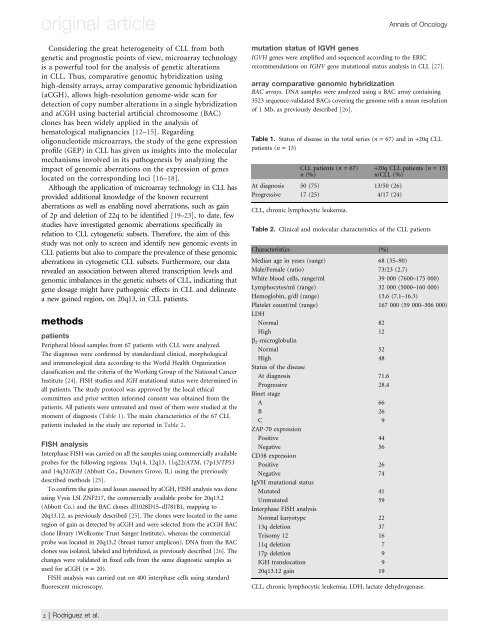Alberto Risueño Pérez - Gredos - Universidad de Salamanca
Alberto Risueño Pérez - Gredos - Universidad de Salamanca
Alberto Risueño Pérez - Gredos - Universidad de Salamanca
Create successful ePaper yourself
Turn your PDF publications into a flip-book with our unique Google optimized e-Paper software.
original article<br />
Consi<strong>de</strong>ring the great heterogeneity of CLL from both<br />
genetic and prognostic points of view, microarray technology<br />
is a powerful tool for the analysis of genetic alterations<br />
in CLL. Thus, comparative genomic hybridization using<br />
high-<strong>de</strong>nsity arrays, array comparative genomic hybridization<br />
(aCGH), allows high-resolution genome-wi<strong>de</strong> scan for<br />
<strong>de</strong>tection of copy number alterations in a single hybridization<br />
and aCGH using bacterial artificial chromosome (BAC)<br />
clones has been wi<strong>de</strong>ly applied in the analysis of<br />
hematological malignancies [12–15]. Regarding<br />
oligonucleoti<strong>de</strong> microarrays, the study of the gene expression<br />
profile (GEP) in CLL has given us insights into the molecular<br />
mechanisms involved in its pathogenesis by analyzing the<br />
impact of genomic aberrations on the expression of genes<br />
located on the corresponding loci [16–18].<br />
Although the application of microarray technology in CLL has<br />
provi<strong>de</strong>d additional knowledge of the known recurrent<br />
aberrations as well as enabling novel aberrations, such as gain<br />
of 2p and <strong>de</strong>letion of 22q to be i<strong>de</strong>ntified [19–23], to date, few<br />
studies have investigated genomic aberrations specifically in<br />
relation to CLL cytogenetic subsets. Therefore, the aim of this<br />
study was not only to screen and i<strong>de</strong>ntify new genomic events in<br />
CLL patients but also to compare the prevalence of these genomic<br />
aberrations in cytogenetic CLL subsets. Furthermore, our data<br />
revealed an association between altered transcription levels and<br />
genomic imbalances in the genetic subsets of CLL, indicating that<br />
gene dosage might have pathogenic effects in CLL and <strong>de</strong>lineate<br />
a new gained region, on 20q13, in CLL patients.<br />
methods<br />
patients<br />
Peripheral blood samples from 67 patients with CLL were analyzed.<br />
The diagnoses were confirmed by standardized clinical, morphological<br />
and immunological data according to the World Health Organization<br />
classification and the criteria of the Working Group of the National Cancer<br />
Institute [24]. FISH studies and IGH mutational status were <strong>de</strong>termined in<br />
all patients. The study protocol was approved by the local ethical<br />
committees and prior written informed consent was obtained from the<br />
patients. All patients were untreated and most of them were studied at the<br />
moment of diagnosis (Table 1). The main characteristics of the 67 CLL<br />
patients inclu<strong>de</strong>d in the study are reported in Table 2.<br />
FISH analysis<br />
Interphase FISH was carried on all the samples using commercially available<br />
probes for the following regions: 13q14, 12q13, 11q22/ATM, 17p13/TP53<br />
and 14q32/IGH (Abbott Co., Downers Grove, IL) using the previously<br />
<strong>de</strong>scribed methods [25].<br />
To confirm the gains and losses assessed by aCGH, FISH analysis was done<br />
using Vysis LSI ZNF217, the commercially available probe for 20q13.2<br />
(Abbott Co.) and the BAC clones dJ1028D15–dJ781B1, mapping to<br />
20q13.12, as previously <strong>de</strong>scribed [25]. The clones were located in the same<br />
region of gain as <strong>de</strong>tected by aCGH and were selected from the aCGH BAC<br />
clone library (Wellcome Trust Sanger Institute), whereas the commercial<br />
probe was located in 20q13.2 (breast tumor amplicon). DNA from the BAC<br />
clones was isolated, labeled and hybridized, as previously <strong>de</strong>scribed [26]. The<br />
changes were validated in fixed cells from the same diagnostic samples as<br />
used for aCGH (n = 20).<br />
FISH analysis was carried out on 400 interphase cells using standard<br />
fluorescent microscopy.<br />
2 | Rodríguez et al.<br />
mutation status of IGVH genes<br />
IGVH genes were amplified and sequenced according to the ERIC<br />
recommendations on IGHV gene mutational status analysis in CLL [27].<br />
array comparative genomic hybridization<br />
BAC arrays. DNA samples were analyzed using a BAC array containing<br />
3523 sequence-validated BACs covering the genome with a mean resolution<br />
of 1 Mb, as previously <strong>de</strong>scribed [26].<br />
Table 1. Status of disease in the total series (n = 67) and in +20q CLL<br />
patients (n = 13)<br />
CLL patients (n = 67) +20q CLL patients (n = 13)<br />
n (%) n/CLL (%)<br />
At diagnosis 50 (75) 13/50 (26)<br />
Progressive 17 (25) 4/17 (24)<br />
CLL, chronic lymphocytic leukemia.<br />
Annals of Oncology<br />
Table 2. Clinical and molecular characteristics of the CLL patients<br />
Characteristics (%)<br />
Median age in years (range) 68 (35–90)<br />
Male/Female (ratio) 73/23 (2.7)<br />
White blood cells, range/ml 39 000 (7600–175 000)<br />
Lymphocytes/ml (range) 32 000 (5000–160 000)<br />
Hemoglobin, g/dl (range) 13.6 (7.1–16.3)<br />
Platelet count/ml (range)<br />
LDH<br />
167 000 (59 000–306 000)<br />
Normal 82<br />
High<br />
b2-microglobulin 12<br />
Normal 52<br />
High<br />
Status of the disease<br />
48<br />
At diagnosis 71.6<br />
Progressive<br />
Binet stage<br />
28.4<br />
A 66<br />
B 26<br />
C<br />
ZAP-70 expression<br />
9<br />
Positive 44<br />
Negative<br />
CD38 expression<br />
56<br />
Positive 26<br />
Negative<br />
IgVH mutational status<br />
74<br />
Mutated 41<br />
Unmutated<br />
Interphase FISH analysis<br />
59<br />
Normal karyotype 22<br />
13q <strong>de</strong>letion 37<br />
Trisomy 12 16<br />
11q <strong>de</strong>letion 7<br />
17p <strong>de</strong>letion 9<br />
IGH translocation 9<br />
20q13.12 gain 19<br />
CLL, chronic lymphocytic leukemia; LDH, lactate <strong>de</strong>hydrogenase.
















